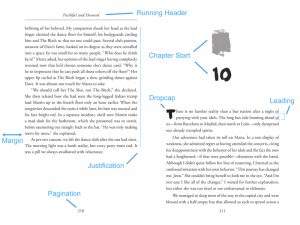
Open a book — any book. It's easy to take for granted how those pages look and flow, how the typeface complements the subject matter and informs the tone and theme of the book, or how the chapter headings display, where the page numbers land, or even the feel and heft of the pages themselves. Every one of these aspects — and more — has been carefully chosen by a book's interior, or layout, designer. (A graphic designer, on the other hand, creates the cover, which is a topic for another blog.)
When you've finished copyediting your book, an interior designer plays a key role in the next phase of self-publishing.
Responsibilities of an Interior Designer
A knowledge of how books are constructed is critical, covering bookmaking conventions, industry standards, and a grasp of how to present information. In a nonfiction book, especially one heavy on information, a designer helps visually organize the hierarchy of material. But more than that, the designer creates visually appealing layouts — and does what's necessary to make your book look as professional and primed for distribution as possible.
The Specifics a Designer Covers
Here's a breakdown of the essential elements a book designer handles:
- Hardcover and/or soft. The decision you and the designer come to on this will affect the cost and size of the book.
- Size and shape of book. Hardcovers tend to range from 6”x9” to 8.5”x11”; trade paperbacks typically anywhere from 5.5”x8.5” (known as digest size, often recommended for books of fewer than 100,000 words) to 6”x9” (aka U.S. trade size, used by many memoirs, nonfiction books, and novels).
- Typography. Includes the choice of:
- Typeface (e.g., Palatino, Calibri, Arial, Times New Roman), which should convey the tone of the book's genre
- Font, or treatment of typeface (e.g., size and weight of type, italics, etc.)
- Treatment of display pages. Chapter openings and headings (numbers vs. numerals, all caps vs. sentence style, design embellishments, etc.).
- Headings and subheads. Using the proper typography to guide readers through the hierarchy of information.
- Margins. How much blank space is around the body of the page.
- Pagination (aka folios). Where the page numbers fall (lower or upper edge? centered or in the corners?) and which pages contain an unseen (blind) folio, even if that number is counted.
- Running headers or footers. Optional elements that help readers identify where they are in the book by including the book title, author's name, and/or chapter title either at the top or bottom of the page.
- Kerning. Spacing of the typeset words and letters to make the type seem uniform — rarely noticeable when done right but woefully evident when not.
- Leading. The amount of space between the lines of type.
- Justification. Whether the right end of each line is aligned or is ragged.
- Widows and orphans. Single lines of a paragraph that lie at the bottom or top of a page or single words that lie on their own line of a paragraph. Designers manipulate text flow to avoid both widows and orphans.
- Paper. The weight and color of the pages themselves, which can influence the look, feel, and cost of your book.
Hiring a Book Designer
Book designers once tended to have degrees in graphic design or art, but with modern design software such as Adobe InDesign, QuarkXPress, and Affinity Publisher, a book designer with experience and good instincts can produce professional-quality results. Ask to see a portfolio to get an idea of range and style. The best designer I ever worked with didn't originally start out designing; he found his way to it and has produced excellent, often brilliant work.
To find a designer, get recommendations from editors and other authors, especially those who've published books in your genre. You can also find designers mentioned in the acknowledgments of books whose presentation you find appealing. And then there are websites and groups offering design services, such as 99Designs, EBook Launch, Fiverr, and Book Baby. (I've never used one, so caveat emptor.) The best designers will read your book to get a sense of the subject matter and author's voice so they can most authentically present the book in its visual form.
Costs of Interior Book Design
Prices range considerably, depending on your book's length and complexity, as well as a designer's experience and how tight a schedule you are working with. Are there charts, pull quotes, illustrations, photos? If so, do they need to be placed individually throughout the book or can they be grouped together? Will you include footnotes or back matter such as a bibliography or index? All these elements contribute to the complexity of a design job.
That said, expect to pay a seasoned designer anywhere from $500 to $1,000 a project for a relatively straightforward book with perhaps one additional complexity mentioned above. Much depends on whether you're looking for a custom design or one that can be dropped into a template. Book designing is a craft, but it's also something of an art. And as is so often the case, you get what you pay for.
- Why You Need an Interior Designer for Your Self-Published Book - June 7, 2022
- 6 Reasons Why You Should Write Your Book in Microsoft Word - December 8, 2020
- Tricks of the Editing Trade: Word, Track Changes, and the Master Document - May 16, 2019

